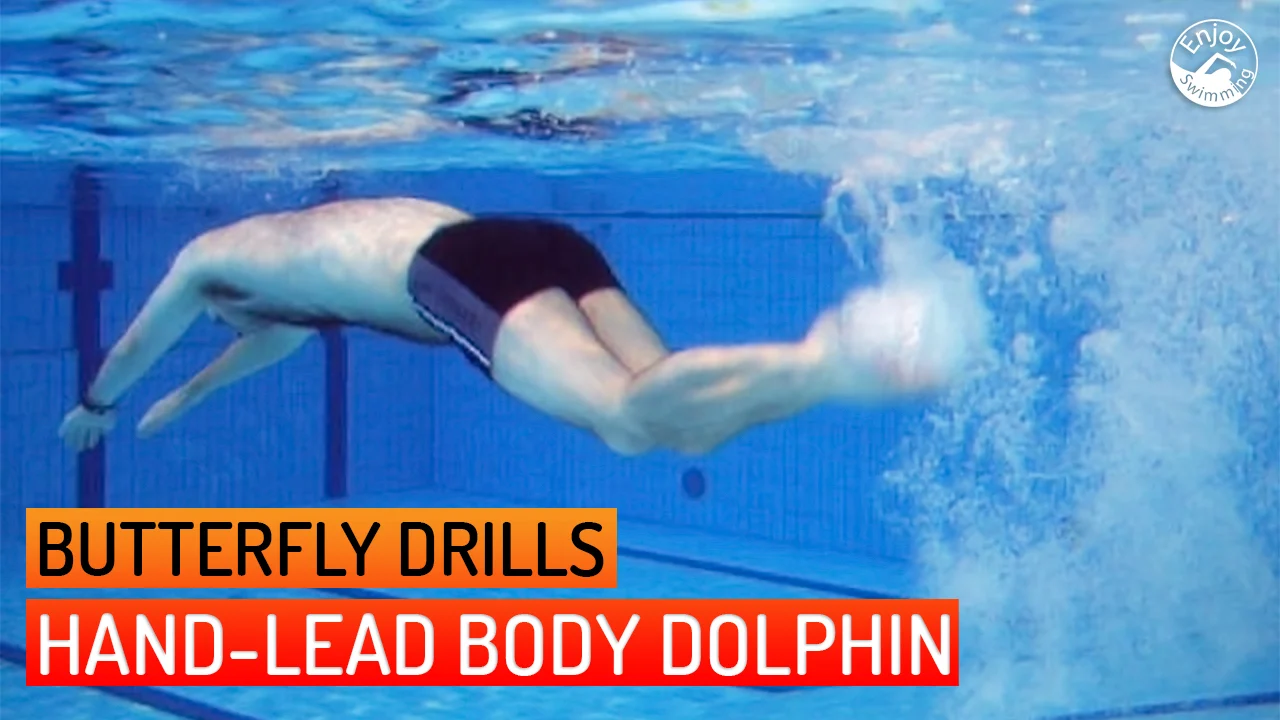Hand-Lead Body Dolphin is a swimming drill to practice when learning the butterfly stroke.
In this drill, you extend your arms forward while performing body undulation/dolphin kick cycles, instead of keeping your arms at your sides as you did in Head-Lead Body Dolphin.
Hand-Lead Body Dolphin follows Head-Lead Body Dolphin and precedes Slide to the Corners in our series of swimming drills for the butterfly.

It makes sense to practice the body undulation both with your arms extended in front of you and with your arms resting at your sides, as you will encounter similar positions and movements while swimming whole-stroke butterfly.
Video Demonstration
The following video illustrates this drill:
Drill Instructions
- Push off from the wall and assume a horizontal position, with your face down.
- Extend your arms in front of you, with your hands shoulder-width apart.
- To begin the drill cycle, press your chest and head down into the water by contracting your core, then release the pressure.
- As you release the pressure, your chest should rise to the water’s surface, thanks to the lung’s buoyancy.
- Push your hips down as your chest moves up, then release your hips.
- As your hips move upward, push your chest down to start a new cycle, and so on.
- Your legs should follow along with your hips in their up-and-down movements, performing relaxed dolphin kicks.
- Using these undulating body movements and dolphin kicks, move forward in the water.
- The body undulation is like a wave that travels from your arms through the body to your feet.
Breathing
To start, perform the drill several times in a row while holding your breath, then stop to breathe. Perform the drill a few more times, and then stop to breathe again. Repeat this sequence. Alternatively, use a swim snorkel so you don’t have to stop to breathe.
Incorporate breathing once you can perform several body undulation/dolphin kick cycles relatively easily while holding your breath.
To perform a body undulation with breathing, release your chest and lift your head and torso above the water. Take a quick breath as soon as your mouth is above the surface, then lower your head and torso into the water again.
Your head should remain in a neutral position while inhaling, with your gaze directed downward and slightly forward. Do not let your chin jut forward.
Begin to exhale as soon as your face is back in the water, and continue to exhale until the next breathing body undulation.
At first, breathe only every five to six body undulations, so that you can regain your rhythm between breaths. Then, increase the breathing frequency as you become more proficient in this drill.
Additional Tips
Performing body undulations is easier when your arms are stretched out in front of you rather than at your sides because you can exert more leverage on the water.
Also, because your body is longer when your arms are extended forward, it will take fewer undulations to reach the other side of the pool, and you don’t need to perform them as quickly to obtain good propulsion.
If you find this drill challenging, you can always use swim fins. They are especially useful if you have limited flexibility in your ankles. Then, as your technique improves, you can gradually get rid of the fins.
Initiate the kick from your hips, not your knees, and stay relaxed while you do it. When you swim butterfly, the body undulation drives the dolphin kick, not the other way around.
As you practice these body dolphin drills, be aware of how each part of your body is moving. Stay focused and work on coordinating the movements. Mastering the undulation is a vital first step for achieving an efficient butterfly.
This article provides additional swimming drills for the body undulation and dolphin kick.
Learning Path for the Butterfly Stroke
Below is an overview of our series of articles on learning the butterfly stroke. Each article in this series contains one or more drills that have to be mastered. The current article is highlighted:
Once you have gone through all the steps of this learning path, you should be able to swim butterfly without any problems.
Good luck!
